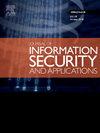SNOW 5G流密码异或版本的差分故障攻击
IF 3.8
2区 计算机科学
Q2 COMPUTER SCIENCE, INFORMATION SYSTEMS
Journal of Information Security and Applications
Pub Date : 2025-06-07
DOI:10.1016/j.jisa.2025.104108
引用次数: 0
摘要
本文提出了一种针对SNOW 5G XOR版本的差分故障攻击(DFA),其中模块化216加法被位向XOR取代。在密钥流生成阶段,使用有限状态机(FSM)中的单字节故障,我们演示了896位内部状态和256位秘密密钥的完全恢复。通过在密钥流生成阶段向FSM的寄存器R1和R2中注入一个单字节故障,我们求解了由密钥流差异导出的线性方程,分别获得了25字节和14字节内部状态的平均21.01个候选值。此外,我们提出了一种基于键流差分模式的故障定时和定位方法,从R1和R2的多时间状态中确定一次内部状态。通过利用4次碰撞攻击,攻击复杂度降低到219.115的时间复杂度和212.697的存储复杂度(16个故障)。对于密钥恢复,我们将问题表述为初始化阶段第14次和第15次恢复R2,并提出了一种基于子空间轨迹的故障定位技术。该技术通过分析键流差异偏差来唯一地识别单字节FSM故障的位置,即使不同的故障位置引起相同的差异模式。最后,我们推导了初始化阶段由R2第14 /15次和R1第13 /14次单字节故障引起的差分传播模式,并提出了两种关键恢复方案。当故障位置未知时,使用80个故障平均产生225.877个候选密钥。在故障定位可控的情况下,使用8个故障平均产生28个候选键,存储复杂度为24.01,时间复杂度为217.16。本文章由计算机程序翻译,如有差异,请以英文原文为准。
Differential fault attack on the XOR version of SNOW 5G stream cipher
This paper presents a differential fault attack (DFA) on the XOR version of SNOW 5G, in which modular addition is replaced by bitwise XOR. Using single-byte faults in the Finite State Machine (FSM) during the keystream generation phase, we demonstrate a complete recovery of the 896-bit internal state and 256-bit secret key. By injecting a single-byte fault into registers R1 and R2 of FSM during the keystream generation phase, we solve linear equations derived from keystream differences, obtaining an average of candidate values for 25 bytes and 14 bytes of the internal state, respectively. Furthermore, we present a fault timing and location determination method based on keystream differential patterns, determining the internal state at one time from the multi-time state of R1 and R2. By leveraging 4 collision attacks, the attack complexity is reduced to a time complexity of and a storage complexity of (using 16 faults). For key recovery, we formulate the problem as recovering R2 at 14th and 15th time during the initialization phase, and propose a subspace trail-based fault localization technique. This technique uniquely identifies the location of single-byte FSM faults by analyzing keystream differential deviations, even when distinct fault positions induce identical differential patterns. Finally, we derive the differential propagation patterns induced by single-byte faults in R2 at 14th/15th time and R1 at 13th/14th time during initialization phase, and propose two key recovery schemes. When fault location is unknown, using 80 faults yields an average of candidate keys. When fault location is controllable, using 8 faults yields an average of candidate keys, with a storage complexity of and time complexity of .
求助全文
通过发布文献求助,成功后即可免费获取论文全文。
去求助
来源期刊

Journal of Information Security and Applications
Computer Science-Computer Networks and Communications
CiteScore
10.90
自引率
5.40%
发文量
206
审稿时长
56 days
期刊介绍:
Journal of Information Security and Applications (JISA) focuses on the original research and practice-driven applications with relevance to information security and applications. JISA provides a common linkage between a vibrant scientific and research community and industry professionals by offering a clear view on modern problems and challenges in information security, as well as identifying promising scientific and "best-practice" solutions. JISA issues offer a balance between original research work and innovative industrial approaches by internationally renowned information security experts and researchers.
 求助内容:
求助内容: 应助结果提醒方式:
应助结果提醒方式:


